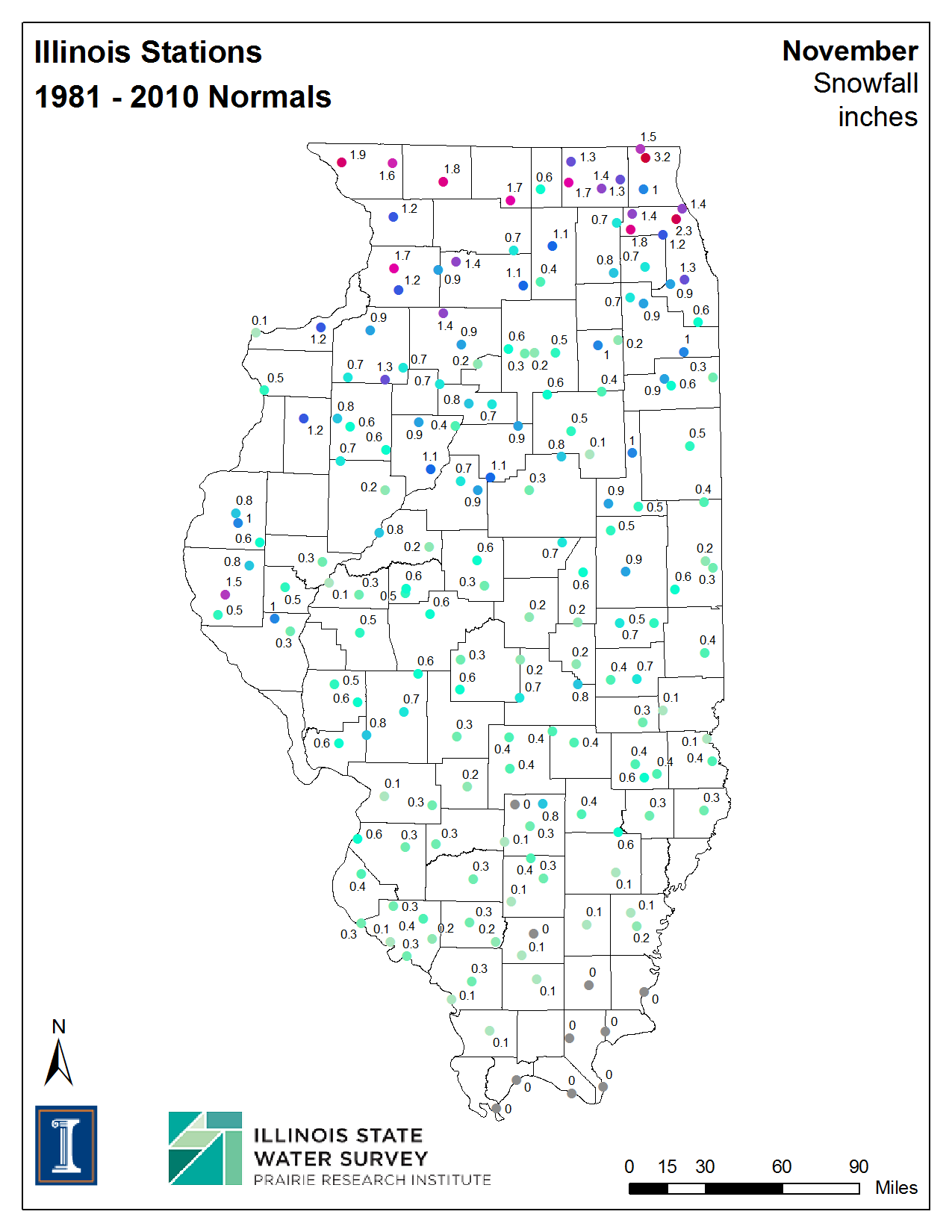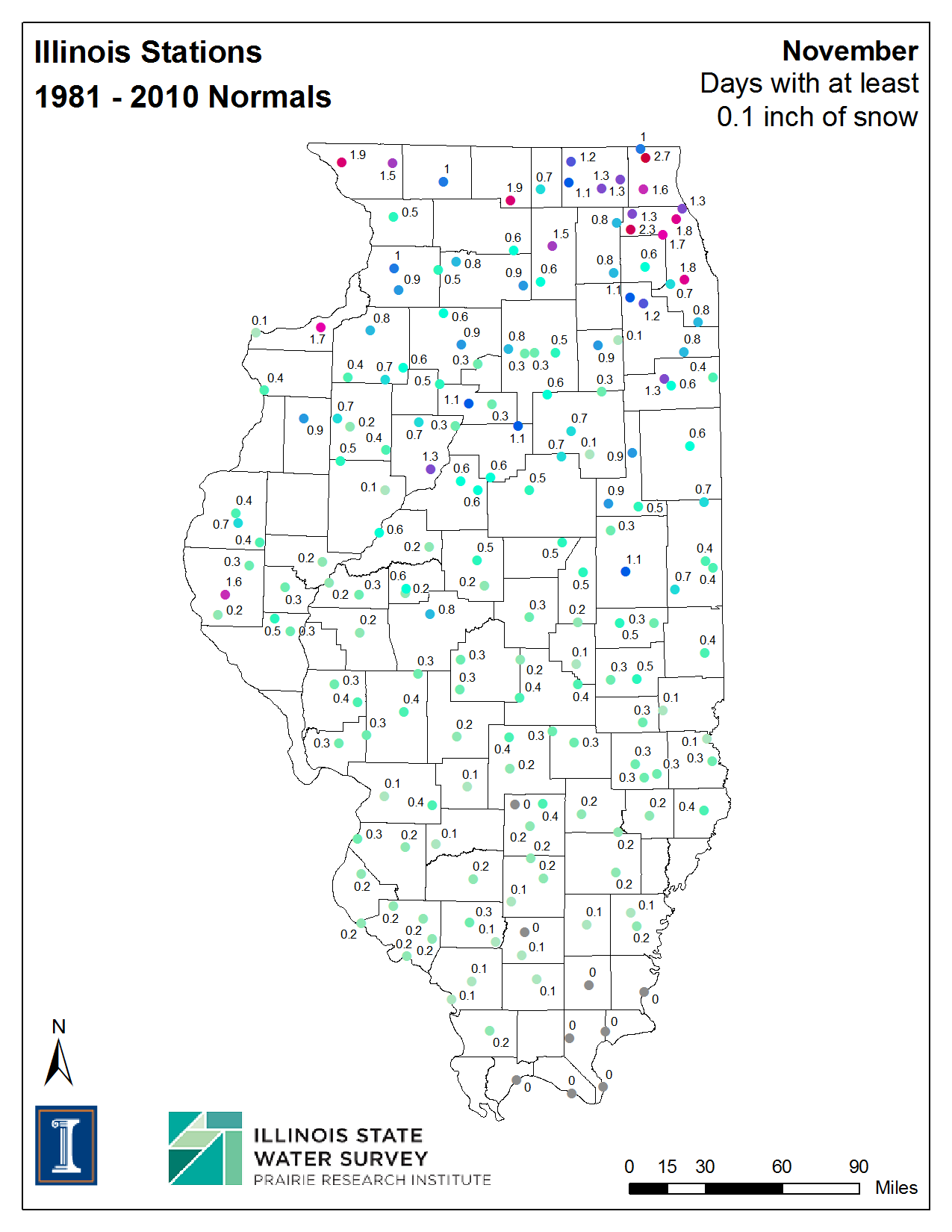The new 1981-2010 normal snowfall data have been released by the National Climatic Data Center. A map of those data for December are shown below. Normal snowfall ranges from barely an inch in far southern Illinois to 8 – 11 inches in many places in northern Illinois. Antioch is the snowiest station with 11.1 inches in December. Besides the total snowfall for the month, you can get maps of number of days with 0.1 inches or more, 1 inch or more, and 10 inches or more.
While southern Illinois gets less snowfall in December, they get more rain. In fact, the map of total precipitation (rainfall plus the water content of snow) shows that southern Illinois is almost twice as wet as northern Illinois. Normal precipitation amounts of 4 to 4.5 inches are common there, compared to around 2 inches for sites in northern Illinois. See second map.
So why is northern Illinois so “dry” compared to southern Illinois in terms of precipitation, even though northern Illinois gets much more snow? It turns out that the water content in snow is not that great. The rule of thumb is that 10 inches of snow melts into 1 inch of water (10:1). However, the actual ratio varies from storm to storm. I have seen the ratio vary from 4:1 for a wet, slushy snow to 20:1 for a light, powdery snow. So that 8 inches of snow in your driveway may not have any more water in it than the rain from a typical summertime thunderstorm.
You can explore all the new normals data in maps and tables for each station at the climate normals page on the State Climatologists website.


Drought Leaves Illinois
Drought has left the building, at least as far as Illinois is concerned, according to the U.S. Drought Monitor. In a earlier post, I outlined recent conditions in Illinois that pointed towards recovery from this summer’s flash drought.
While conditions have improved steadily, some areas may still be experiencing the impacts of drought. One area in particular is the recovery of Lake Decatur. In addition, some of the smaller rivers and streams in central Illinois are below average for this time of year.

November in Illinois – Warmer and Wetter So Far
Precipitation
Based on preliminary numbers, the statewide average precipitation for the first 15 days of November in Illinois was 2.8 inches. That is 1.2 inches above average or 171 percent of average. The largest rainfall totals were in western Illinois, four to nearly five inches in some places, where it was most needed.
Soil Moisture
Soil moisture readings from Water Survey sites at Perry, Monmouth, Peoria, and Springfield, show that the water content in the top 20 inches of the soil is at 30-35 percent, nearly ideal for this time of year. That is a big improvement over this summer when the water content was only 15-20 percent in the top 20 inches.
With 97 percent of the corn and 98 percent of the soybeans harvested and winter wheat in good shape, many of the agricultural impacts of the 2011 “flash” drought in western and central Illinois are done. The recent precipitation and the precipitation in the next few months should leave Illinois soils fully recharged for spring.
Temperature
The statewide average temperature for the first 15 days of November in Illinois was 49.2 degrees. That is 4.8 degrees above average.


November Snowfall in Illinois
We have generated maps of the new 1981-2010 normals for Illinois, including the new November snowfall normals and the number of days with “measurable” snowfall (0.1 inches or more). See the maps below (click to enlarge).
While we may sometimes see snow in late October, November is normally the start to the snowfall season for much of Illinois. However, the average amounts are small by the standard of later winter months, ranging from 1-2 inches in northern Illinois to less than an inch in central Illinois to zero in southeastern Illinois.
The number of days with measurable snowfall, or snowfall frequency, is uncannily like the snowfall totals. The snowfall frequency ranges from 1-2 days for November in northern Illinois, to less than a day in central Illinois, to zero in southeastern Illinois. When the frequency drops below one day it means snowfall does not occur every year. For example, an average frequency of 0.5 days means it happens only once every 2 years on average.



